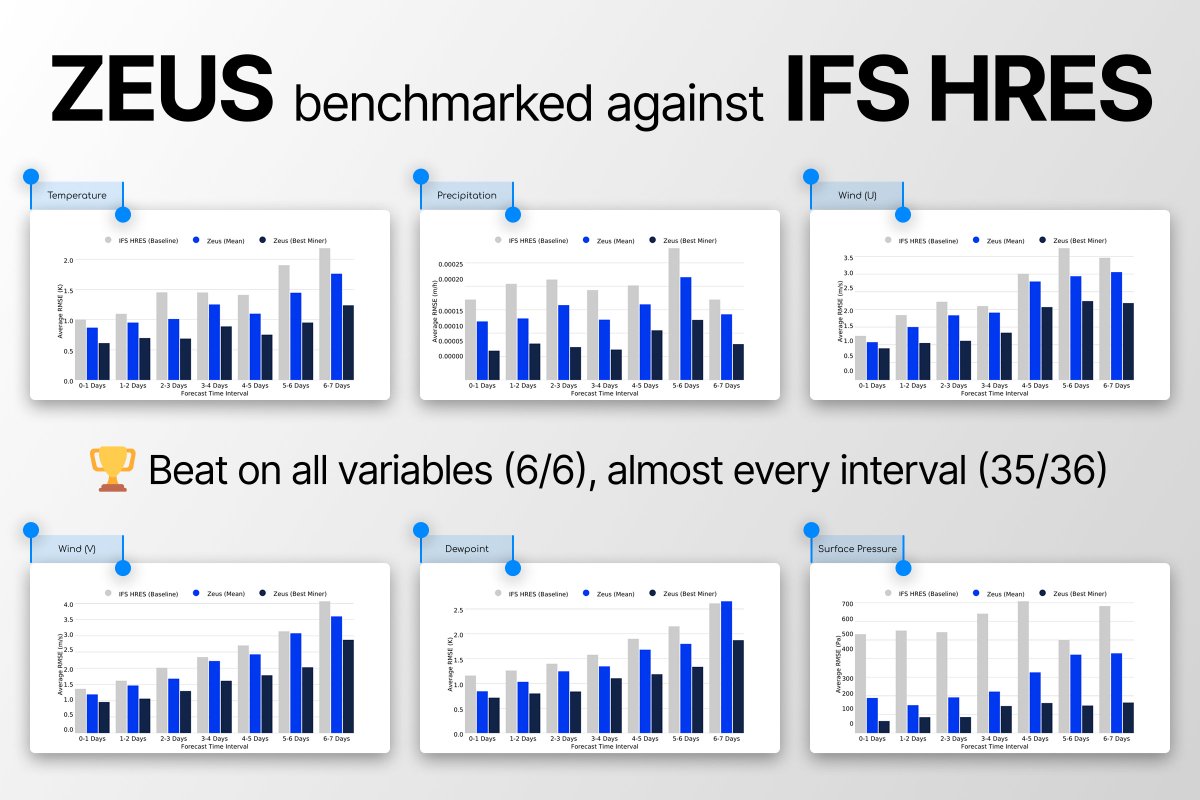
By: @CryptoZPunisher
In a world where weather forecasts dictate everything from flight routes to energy markets, accuracy is king. Yet until now, that accuracy has relied on costly, centralized supercomputers, the ECMWF (European Centre for Medium-Range Weather Forecasts) and NOAA GFS being the global gold standards.
With Zeus, those monopolies are being challenged. Subnet 18 of the Bittensor network, developed by the Dutch team Orpheus AI, offers a radical alternative: decentralized weather forecasting, powered by distributed AI models and secured by blockchain incentives.
A New Era of Weather Prediction
The whitepaper “Zeus: Decentralized Weather Forecasting” (February 2025) lays the foundation for a system capable of rivaling the world’s leading meteorological models.
Zeus leverages open ERA5 data from the European Copernicus Climate Data Store, encompassing over 80 years of atmospheric records. These data streams are distributed to a network of miners (who generate forecasts) and validators (who test them).
Each miner receives a forecast challenge: a random geographic grid (0.25° resolution), a forecast window (1–24 hours), and a specific weather variable to predict, such as 2 m temperature, wind, pressure, or humidity.
Validators then compare the predictions to ground-truth values from Copernicus and distribute TAO rewards based on accuracy.
A Competitive Intelligence Engine
Zeus turns weather forecasting into an open scientific competition. Each model is evaluated using a weighted RMSE that adjusts for the natural difficulty of each challenge, based on regional weather variability.
Predicting a calm patch of the Pacific earns little. But nailing a forecast over the Alps or tropical regions, where conditions shift rapidly, is far more rewarding.
This architecture promotes:
- Methodological diversity (LSTM, CNNs, Transformers, MLPs, etc.)
- Natural selection of top-performing models
- Continuous improvement without centralized orchestration
Results: Zeus Outperforms the ECMWF IFS HRES
In late October 2025, Zeus released historic benchmarks showing that the average miner already outperforms the ECMWF’s IFS HRES, the long-standing “gold standard” of global forecasting.

Visual summary: Zeus beat ECMWF’s IFS HRES across all six weather variables (6/6) and on almost every forecast interval (35/36). ➡️
Orpheus-AI/SN18-Benchmarking: Repository to share benchmarks regarding Zeus

In other words: decentralized forecasting has now officially beaten one of the world’s most advanced meteorological systems.
The team also announced upcoming evaluations against Microsoft Aurora, one of the most sophisticated AI-driven forecasting models to date.
Zeus × x402: The Dawn of Agentic Commerce
In October 2025, Zeus became the first weather-data provider within the x402 ecosystem. Through its integration via Nexus (by Thirdweb), autonomous agents can now:
- Pay and consume Zeus forecasts in real time
- Act immediately on weather data (for example, adjusting logistics or commodity strategies)
- Transact on-chain, using blockchain-native HTTP payments
This marks the rise of agentic commerce, autonomous AI agents making economic decisions based on live weather intelligence.
X account: @thirdweb ➡️ nexus.thirdweb.com

Lightweight Architecture and Open Science
Zeus is designed for accessibility:
- Validators run entirely on CPU (≥ 8 GB RAM, 3 MB/s bandwidth).
- Miners are free to use any ML framework or model architecture.
All forecasts, scores, and rewards are transparently recorded on-chain through Bittensor, ensuring full traceability while encouraging open participation from independent developers and researchers.
The Team Behind Zeus
Orpheus AI, based in the Netherlands, combines academic rigor with startup agility. The team collaborates closely with the University of Applied Sciences of Amsterdam (HvA), where they lead hackathons and workshops on decentralized forecasting models.
Team members:
- Wouter Haringhuizen — Co-founder
- Travis van Cornewal — Co-founder
- Egill de Visser — Business Developer
- Éric Langezaal, Vasilis Vythoulkas, Daniël van Dijk — Machine Learning Engineers
- Sebastian Bos — Analyst
- Mert Özbalaban — Full Stack Developer

What Comes Next
Future developments include additional weather variables — many of which are already active on the subnet (wind, pressure, humidity), while others like radiation and cloud cover are next in line.
The most significant upcoming improvement, however, is the extension of the validation layer: integrating off-the-grid observational data as ground truth, via an additional mechanism (previously a sub-subnet). This step will greatly strengthen real-world data coverage and validation integrity.
While Zeus is not directly focused on energy forecasting, the team is exploring use cases for traders in energy and commodity markets, including probabilistic forecasting and dynamic querying of peak demand windows.
Several major announcements are also planned, with an upcoming presentation in London (CryptoAI Day – Nov 22, 2025) hosted by Siam Kidd.
Useful Links
- GitHub : github.com/Orpheus-AI/Zeus
- Whitepaper : Zeus_whitepaper_v0_1.pdf
- Official Site : zeussubnet.com
- X (Zeus Subnet) : @zeussubnet
- X (Wouter Haringhuizen) @wouterhar
- X (Travis van Cornewal) @0xtravvv
- X (Egill) : @egillwx
- X (Sebastian Bos) @seb_zeus
- X (Hermes) : @Hermes_Agent
- Taostats link.
Personal Note & Hypothesis
As I was writing this article, I couldn’t shake the feeling that the team behind Zeus (SN18) is cooking up something truly special. This is, of course, my personal hypothesis, but it seems entirely plausible that their weather prediction models could eventually be monetized through platforms like Polymarket, where accurate forecasts have tangible financial value?
Moreover, given Orpheus AI’s recent momentum and growing visibility, I wouldn’t be surprised to see strategic partnerships announced in the coming weeks.
Stay tuned, major news is likely to drop before the end of the month.




Be the first to comment